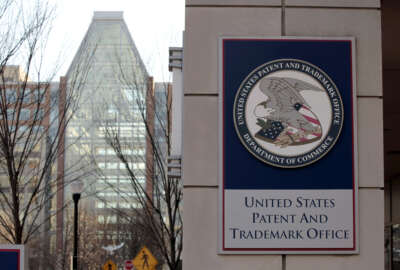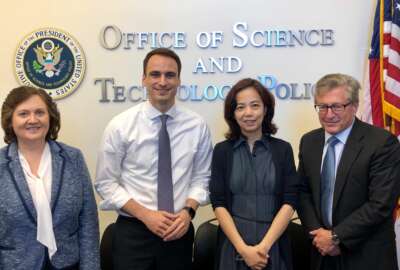

The U.S. Patent and Trademark Office enlisted artificial intelligence technology from IBM which is also to helping inventors navigate and understand prior art.
Best listening experience is on Chrome, Firefox or Safari. Subscribe to Federal Drive’s daily audio interviews on Apple Podcasts or PodcastOne.
Patent applications are on the rise. Successful ones require knowing what else is out there in the inventor’s field that’s called prior art, which is also growing. To help inventors navigate and understand prior art the U.S. Patent and Trademark Office has enlisted artificial intelligence technology from IBM. The project is called Watson Demonstration System. Here with details from IBM’s expert labs team, Graham Katz talked to the Federal Drive with Tom Temin.
Interview transcript:
Tom Temin: What is the purpose mainly for USPTO in deploying the system, and then we’ll get into how it all works.
Graham Katz: You know, a patent is fundamentally an exclusive right granted for an invention, an invention is a new way of doing something. And so when you apply for a patent, you need to show the patent office that the idea is novel and new. And that means that it’s not covered by something that’s already out there having been patented or published, and that is called prior art investigation. So for a patentor to decide even if they want to pursue the patent application, that its worth an investment in the patent application, that significant investment in time and money for an inventor would want to determine whether their idea is actually novel. And determining the novelty of the expression of an idea is the prior art investigation. And so we have been trying to facilitate the prior art investigation for novice patentors with our new AI technology.
Tom Temin: And is one of the issues the fact that because of the internet, and because of the explosion in all kinds of methodologies that are online, that prior art itself has exploded versus what it was, say in 1890, if you had a new valve gear that you invented for a locomotive?
Graham Katz: Exactly, so prior art has expanded, there’s investigation going on around the world, right? There’s patenting in the U.S. that’s governed by the U.S. Patent Office, but there are patent offices all over the world that need to be investigated for prior art. And there’s obviously the scientific literature, which is expanding tremendously, all of which needs to be investigated. Our tool, the tool that you talked about is a demonstration project. And we’re limited in the data that we’re looking at to the U.S. patents, but fundamentally what you say is correct. There’s a huge growth in prior art, because there’s just much more inventing going on.
Tom Temin: And just as a point of reference, could this technology also be deployed to the patent examiner’s because don’t they have the issue of exploring prior art?
Graham Katz: Yes, absolutely. We, of course at IBM would love it if the U.S. Patent Office were to use our technology in their patent examining work. We’ve used it internally in our patent investigation. As you may know, IBM is a very large patentor. We’ve been the leading U.S. patentor or for the last I think, 29 years. And we havea large IP development team internally. And we’ve used our AI technology internally to do that investigation. As I said before, that’s something you want to do before you pursue the application to make sure that you have a novel idea.
Tom Temin: And tell us how the technology works. I mean, what data do you even know what to go for in order to find out if there is similar prior art? How does this all work?
Graham Katz: Our tool, it’s designed to make the process of sort of patent landscape analysis accessible to the general public by using the AI technology. And there are two aspects of the AI technology that we’ve brought to bear. One facilitates the querying and document retrieval, as we call it, that uses natural language processing, to analyze the data set. So analyze the set of patents that we’ve loaded into the system to see what the key topics are for each patent and the key claims. And the other is what we call the natural language query system, which takes key terms in your query and finds the patents that are relevant to those. So that’s one piece of the technology, that’s a document assessment, we also have a piece that analyzes the similarity of patents, and how similar they are using natural language processing and AI. So that’s one of the technologies that’s called the Watson Discovery Technology. And it’s a technology that’s actually based on you may remember, a number of years ago, we had a system that played the Jeopardy game. So these are products that came out of that research, that system had to find all the information in the large set of loaded data. And this also has to find that information and a large set of loaded data. So we’re using similar technology there.
Tom Temin: What are the domains and topics to which the demonstration is limited at this point?
Graham Katz: So right now, we took the last five years of patent data, it’s about 2 million documents. And that’s what the dataset is that we process for this limited pilot release.
Tom Temin: And if the patent is for a process that might be expressed as software or something, can the discovery find the code or if it’s a patent that might be mechanical or chemical where there’s a diagram, can it find the diagrams?
Graham Katz: So our system as it is now is using just the textual descriptions. The diagrams is a really interesting use case, I know that USPTO is extremely interested in it. And we have research technology that looks at the relationship of diagrams to one another. But that’s not ready to deploy it in our system yet. We’re very excited about it, because we know that that’s upcoming technology that will be out in the near future.
Tom Temin: We’re speaking with Graham Katz. He’s the data and AI technology delivery lead for the expert labs team at IBM. And you mentioned that you search patents that are already there. And I guess we’re up to almost, I think north of 11 million patents now. I was there for the 10 millionth ceremony, but it’s accelerating. What about prior art or art that is not patented? that’s out there that might be rivaling what it is that an inventor asserts, should they care about that?
Graham Katz: They should totally care about that. And that is a real challenge, partially for AI technologies, such as what we have when you have a set of documents that you can load in and do the analysis that’s closed, even the 10 million, or I think it’s even up to 17 million. When you look at the applications as well, that’s a feasible amount to load into a data system. But if you’re looking at all of the potential prior art, that requires more than just the natural language processing of the existing art, but the ability to find it, and then there are issues about copyright and so on that come into play. For many years, we had a stream of news data that we did at the end natural language processing of every week. And we would use that as the basis for looking at prior art for things that were published in the news feeds. But that’s really only a small selection. So the challenge you’ve identified is a big one.
Tom Temin: So the basic utility, then that this demonstration offers is for inventors to see if something is already patented, that is close to what they’re trying to do, and maybe head off applications that don’t have much of a chance.
Graham Katz: Absolutely. And the other side of the utility is to facilitate any of this for a novice patentor. So one of the USPTOs sort of missions is to expand the range of people who can even be involved in the process to accelerate inventing and to democratize the invention process. And another piece of our technology that we’ve been using is our conversational AI technology that guides the novice inventor through the inventing process. So that’s even more important in some sense, then the patent query is the guiding of the user through the inventing process. What are the things that you need to do to find prior art? What should you look at in the landscape? What is the meaning of terminology in the patent domain? What is an assignee? What is a CPC code? And we have a conversational AI that answers those questions for the novice user. And that’s a real innovation here.
Tom Temin: So it’s not a stretch to say this is really an important customer experience extension for the Patent and Trademark Office.
Graham Katz: Exactly. Because patenting has such unique and specific terminology. You know, prior art means something very specific, assignee means something specific, application grant, all have specific meanings. And the process itself, you know, I do patenting myself as an IBMer, we are encouraged to do that. The processing itself is something you need to learn and we at IBM Support the USPTO’s mission goal of expanding that invention space.
Tom Temin: And what is presented to the user, is there a website they can go to and you type something in a search box? Is it that simple?
Graham Katz: It’s sort of that simple. There’s a website that you go to the program that Scott Beliveau set up, the chief of enterprise advanced analytics, has this website that he has a number of vendors providing their advanced technology in a sort of pilot program approach. And our technology is one of those on the website. And anybody out there right now can go to the website developer.uspto.gov. And look at our IP advisor demonstration system, it comes up, it’s got a little user interface, it’s got a chat bot with it.
Tom Temin: Alright, I’m gonna try it myself. Let me a few minutes.
Graham Katz: We’d love to get feedback on that. That’s one of the goals of the USPTO. And this is to get technology out there that maybe hadn’t been used in the patenting domain and see if it’s useful for the general public.
Tom Temin: Sure. And it’s going to be up till November 30, correct?
Graham Katz: That’s correct. It’s up till November 30. And we’re really excited to have users get on the system and kick the tires.
Tom Temin: And a final question, when you put in a search, does it take milliseconds or do you have to wait a week till all of this gets compiled and returned? And what form does the return take?
Graham Katz: So we’ve got three different sorts of technologies as prior art, there’s landscape analysis, there’s similar patents and the return takes a couple seconds to come back. You’ll see it and the prior art list, the prior art of similar patents allows you to compare patents and what’s similar among them. And the landscape analysis gives you a graph of who the assignees are in a space and what the key terminology is in that space.
Tom Temin: Graham Katz is the data and AI technology delivery lead for the expert labs team at IBM.
Copyright © 2025 Federal News Network. All rights reserved. This website is not intended for users located within the European Economic Area.
Tom Temin is host of the Federal Drive and has been providing insight on federal technology and management issues for more than 30 years.
Follow @tteminWFED


